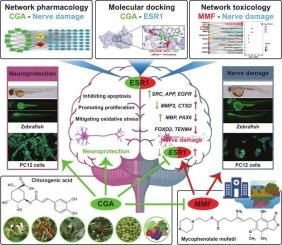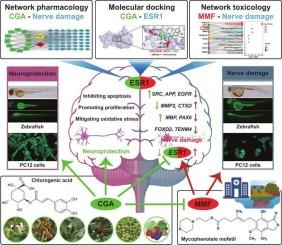Chlorogenic acid counteracts mycophenolate mofetil-induced neurotoxicity in zebrafish and PC12 cells: A potential bioremediation strategy for aquatic pharmaceuticals
IF 9.7
1区 环境科学与生态学
Q1 ENVIRONMENTAL SCIENCES
引用次数: 0
Abstract
Pharmaceutical pollution, particularly from immunosuppressants like mycophenolate mofetil (MMF), has emerged as a significant environmental contaminant in aquatic ecosystems, frequently detected in wastewater at concentrations of 0.1–2.5 μg/L with an occurrence rate exceeding 80 %. This study demonstrates that chlorogenic acid (CGA), a plant-derived polyphenol found in coffee, fruits, and medicinal plants, effectively counters MMF-induced neurotoxicity in both zebrafish and neuronal cells. Specifically, CGA significantly protected PC12 cells from H2O2-induced damage by promoting cell proliferation, inhibiting apoptosis, and reducing oxidative stress in a dose-dependent manner. Exposure to 1 µM MMF reduced PC12 cell proliferation to 46.1 %, increased ROS 2.8-fold, elevated MDA 4.6-fold, and decreased SOD by 40 %. In zebrafish, motor-neuron axonal length was shortened to 56.6 % of control. Co-treatment with 10 µM CGA restored PC12 proliferation to 74.7 %, normalized ROS and MDA levels, and recovered SOD to 89 %. In zebrafish larvae, 100 µM CGA can extend the MMF-induced shortening of motor neuron axon length from 56.6 % to 89.5 %. Network pharmacology and ESR1 knockdown studies identified estrogen receptor 1 (ESR1) as a critical mediator of CGA’s protective effects, supported by surface plasmon resonance (SPR) data confirming direct binding between CGA and ESR1. Notably, ESR1 silencing mitigated MMF-induced neurotoxicity, restoring PC12 cell proliferation to 64.8 % and zebrafish motor-neuron axonal length to 86 % of control. Our findings not only uncover the previously unrecognized environmental neurotoxicity of MMF but also elucidate CGA’s multimodal protective mechanisms via ESR1 modulation. Furthermore, this work highlights the potential of dietary polyphenols as sustainable, eco-friendly agents for bioremediating pharmaceutical pollutants. By providing mechanistic insights into detoxification strategies, our study advances nature-based solutions for mitigating immunosuppressant contamination in aquatic systems, offering a promising approach to address emerging environmental challenges.


绿原酸抵消斑马鱼和PC12细胞中霉酚酸酯诱导的神经毒性:水生药物的潜在生物修复策略
药物污染,特别是免疫抑制剂如霉酚酸酯(MMF),已成为水生生态系统中重要的环境污染物,在废水中经常检测到浓度为0.1-2.5 μg/L,发生率超过80%。这项研究表明,绿原酸(CGA)是一种植物衍生的多酚,存在于咖啡、水果和药用植物中,可有效对抗mmf诱导的斑马鱼和神经元细胞的神经毒性。具体来说,CGA通过促进细胞增殖、抑制细胞凋亡和降低氧化应激,以剂量依赖的方式显著保护PC12细胞免受h2o2诱导的损伤。暴露于1µM MMF可使PC12细胞增殖降低46.1%,ROS增加2.8倍,MDA升高4.6倍,SOD降低40%。斑马鱼运动神经元轴突长度缩短至对照组的56.6%。10µM CGA共处理使PC12的增殖恢复到74.7%,使ROS和MDA水平正常化,使SOD恢复到89%。在斑马鱼幼体中,100µM CGA可将mmf诱导的运动神经元轴突长度缩短从56.6%延长至89.5%。网络药理学和ESR1敲低研究发现雌激素受体1 (ESR1)是CGA保护作用的关键介质,表面等离子体共振(SPR)数据证实了CGA和ESR1之间的直接结合。值得注意的是,ESR1沉默减轻了mmf诱导的神经毒性,使PC12细胞增殖恢复到64.8%,斑马鱼运动神经元轴突长度恢复到对照组的86%。我们的研究结果不仅揭示了MMF之前未被认识到的环境神经毒性,而且阐明了CGA通过ESR1调节的多模态保护机制。此外,这项工作强调了膳食多酚作为生物修复药物污染物的可持续、环保试剂的潜力。通过提供解毒策略的机制见解,我们的研究推进了基于自然的解决方案,以减轻水生系统中的免疫抑制剂污染,为解决新出现的环境挑战提供了一种有希望的方法。
本文章由计算机程序翻译,如有差异,请以英文原文为准。
求助全文
约1分钟内获得全文
求助全文
来源期刊

Environment International
环境科学-环境科学
CiteScore
21.90
自引率
3.40%
发文量
734
审稿时长
2.8 months
期刊介绍:
Environmental Health publishes manuscripts focusing on critical aspects of environmental and occupational medicine, including studies in toxicology and epidemiology, to illuminate the human health implications of exposure to environmental hazards. The journal adopts an open-access model and practices open peer review.
It caters to scientists and practitioners across all environmental science domains, directly or indirectly impacting human health and well-being. With a commitment to enhancing the prevention of environmentally-related health risks, Environmental Health serves as a public health journal for the community and scientists engaged in matters of public health significance concerning the environment.
 求助内容:
求助内容: 应助结果提醒方式:
应助结果提醒方式:


